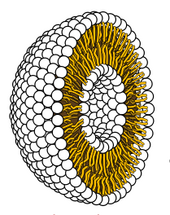The clay theory
Further information: Graham Cairns-Smith § Clay hypothesis
Some clays, notably montmorillonite, have properties that make them plausible accelerators for the emergence of an RNA world: they grow by self-replication of their crystalline pattern, are subject to an analog of natural selection (as the clay "species" that grows fastest in a particular environment rapidly becomes dominant), and can catalyze the formation of RNA molecules.Although this idea has not become the scientific consensus, it still has active supporters.
Cross-section through a liposome
Research in 2003 reported that montmorillonite could also accelerate the conversion of fatty acids into "bubbles", and that the bubbles could encapsulate RNA attached to the clay. Bubbles can then grow by absorbing additional lipids and dividing. The formation of the earliest cells may have been aided by similar processes.
A similar hypothesis presents self-replicating iron-rich clays as the progenitors of nucleotides, lipids and amino acids.




Comments
Post a Comment